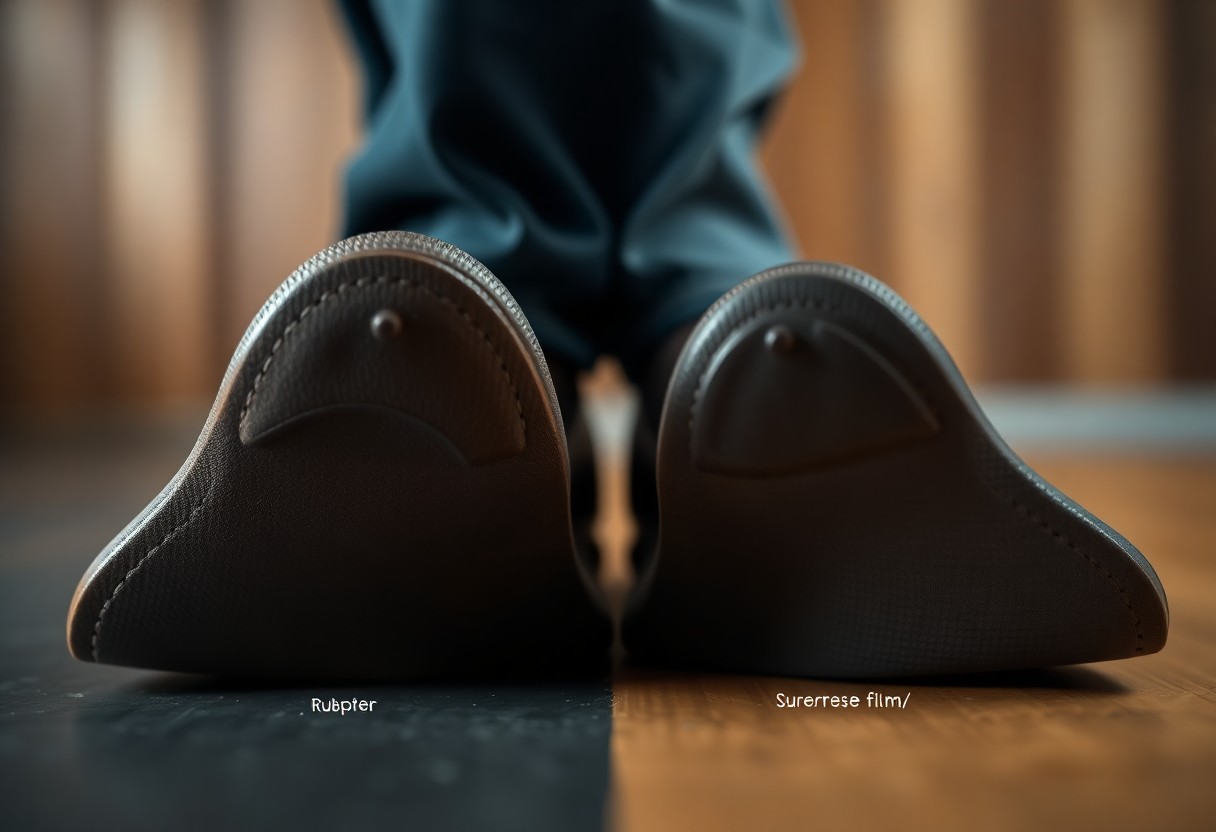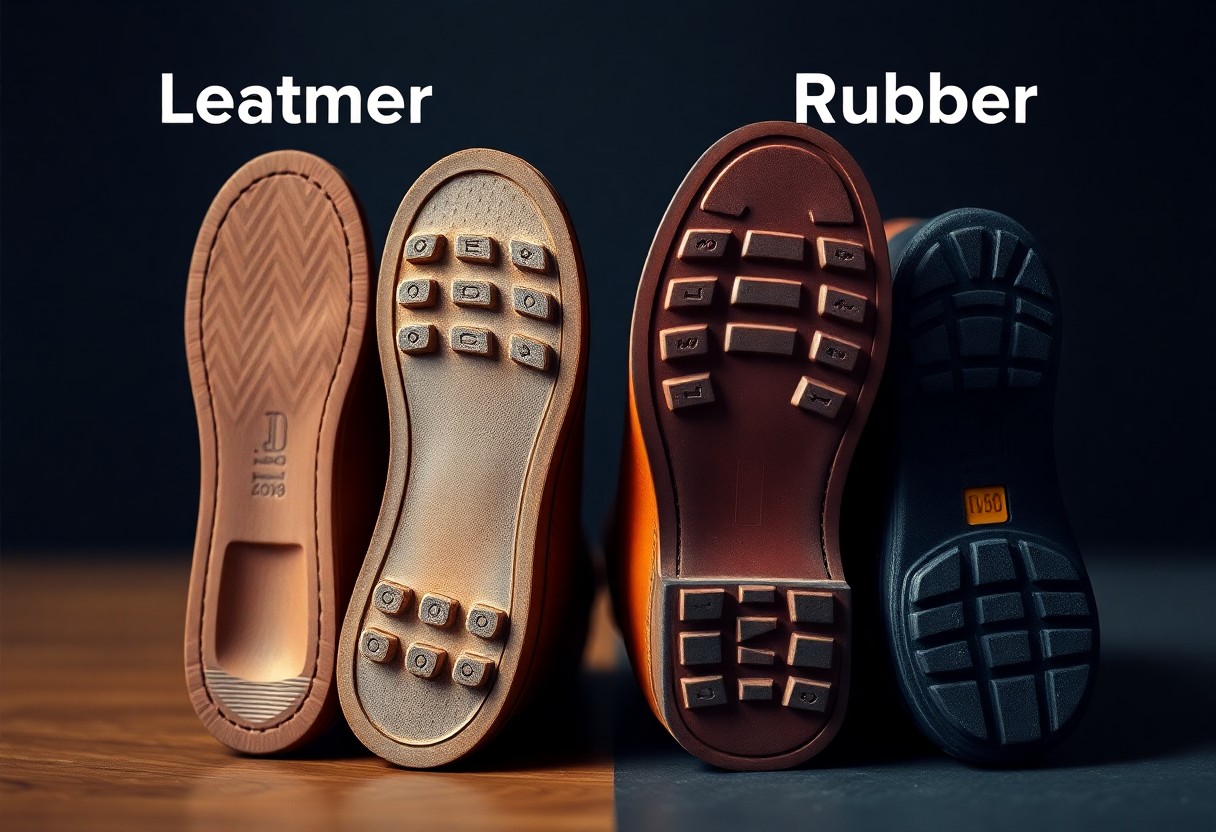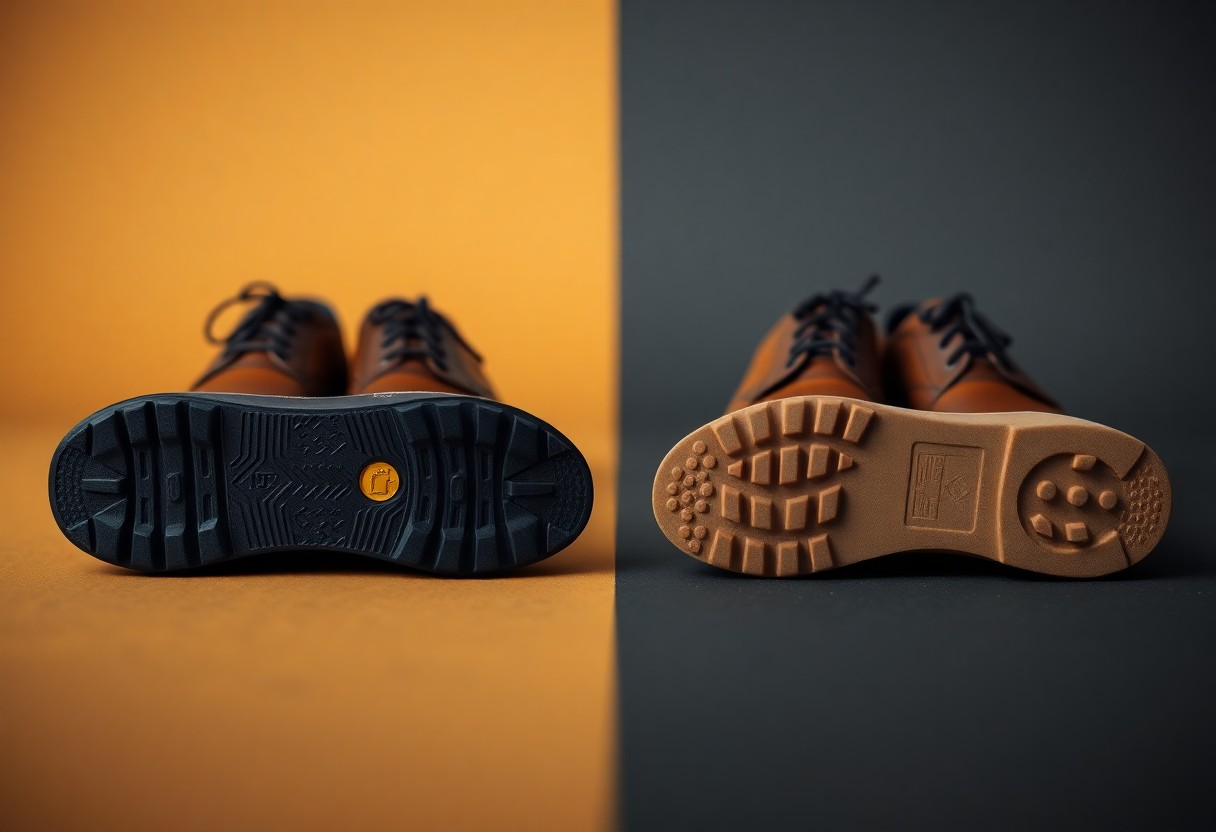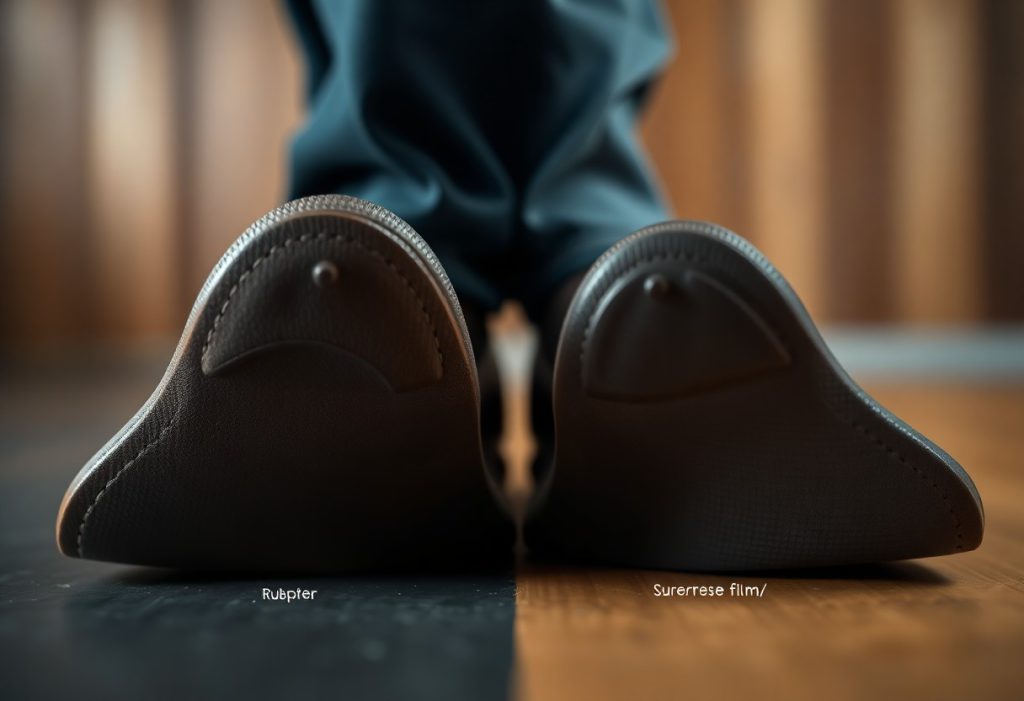When you are in the market for new footwear, a critical decision you face is selecting between leather and rubber soles. This choice is vital as it can significantly impact your comfort and overall walking experience. Leather soles are celebrated for their exceptional breathability and ability to mold to the unique shape of your feet, providing a tailored fit over time. On the other hand, rubber soles are renowned for their outstanding grip and water resistance. While leather soles excel in formal settings, developing a distinct character with use, rubber soles offer immediate comfort and enhanced traction, particularly in wet conditions. This detailed guide will delve into the key differences between these materials, helping you make an informed decision that aligns with your specific footwear needs.

Discover the Distinct Characteristics of Footwear Sole Materials
To make informed footwear choices, it’s essential to understand the various sole materials at your disposal. Each material comes with its own set of unique benefits and drawbacks that significantly affect your daily comfort, the longevity of your shoes, and your overall satisfaction with your purchase. The decision you make regarding leather versus rubber soles will not only influence your walking experience but also play a crucial role in your foot health and the upkeep required for your shoes.
Unpacking the Benefits of Leather Soles for Footwear
For centuries, leather has been the go-to material for high-quality footwear. Shoes that feature leather soles are constructed from natural materials that gradually conform to your feet’s shape, ensuring a personalized fit that enhances comfort as you wear them. This material is excellent for airflow, allowing your feet to breathe and adjust naturally to temperature changes, which is particularly beneficial in varying climates. With regular maintenance, leather soles can provide a lifespan of 3 to 5 years, making them a worthwhile investment for those who prioritize longevity and style in their footwear choices.
Understanding the Key Advantages of Rubber Soles
Rubber soles are widely recognized for their superior water resistance and flexibility right out of the box. Shoes equipped with rubber soles deliver outstanding grip on slippery surfaces and offer immediate shock absorption, ensuring comfort from the moment you slip them on. This material is designed to maintain its shape and performance across a range of weather conditions, making rubber soles a practical choice for daily wear and active lifestyles.
Furthermore, rubber soles ensure consistent performance even in challenging environments. You can typically expect a durability range of 2 to 3 years from high-quality rubber soles, which are easy to maintain. While rubber provides reliable traction and stability, particularly in wet or slippery situations, it may not offer the same level of breathability as leather, which is an important consideration for extended wear.
Evaluating Comfort Factors in Footwear Sole Materials
Understanding how different sole materials affect your daily walking experience is crucial for making the right footwear decision. The choice between leather and rubber soles can have a profound impact on your foot health and overall comfort levels. The ideal sole material should align perfectly with your walking patterns, foot structure, and daily activities to ensure a satisfying and supportive fit.
Exploring the Comfort Elements of Leather Soles
The comfort that leather soles provide is attributed to their unique ability to naturally mold to the shape of your feet and their inherent breathability. Some of the benefits your feet will enjoy include:
- Custom contouring that adapts perfectly to your foot shape
- Natural air circulation that helps to keep your feet dry and comfortable
- Cork layer cushioning that enhances the overall comfort level
- Progressive softening with continuous wear, providing long-term comfort
By recognizing these features, you can make an informed decision that prioritizes your long-term comfort and foot health, ensuring that your investment in footwear is worthwhile.
Immediate Comfort Offered by Rubber Soles in Daily Use
Rubber soles excel in various weather conditions, offering instant comfort and exceptional shock-absorbing qualities. You will experience immediate flexibility with minimal to no break-in period required, making rubber soles ideal for quick, on-the-go use. The advanced technology behind rubber soles delivers excellent grip and water resistance, ensuring safety and comfort in all conditions.
Although rubber does not conform to your feet in the same way leather does, it consistently provides excellent shock absorption and retains its shape, offering protection from hard impacts. This makes rubber soles particularly suitable for extensive urban walking, enhancing your comfort in bustling environments where foot fatigue can be an issue.
Assessing the Durability of Footwear Sole Materials
When considering your options between leather and rubber soles, it’s essential to evaluate their different wear patterns and overall longevity. Your walking habits and local weather conditions can significantly affect the lifespan of your soles. Each material possesses unique strengths in terms of durability, but their effectiveness will vary depending on how they are used and maintained over time.
The Long-lasting Durability of Leather Soles Explained
With proper care and maintenance, leather soles can provide exceptional durability. When adequately protected from excessive moisture and equipped with toe taps, your leather-soled shoes can last anywhere from 3 to 5 years with regular use. The quality of leather can be enhanced by utilizing multiple layers; for instance, a triple leather sole can outperform many alternatives. However, it is critical to keep these soles dry and well-maintained to maximize their lifespan.
The Robustness of Rubber Soles and Their Performance
Rubber soles are well-known for their outstanding resistance to water and wear encountered in daily life. Rubber-soled shoes can withstand demanding conditions and generally last between 2 to 4 years under regular use. These soles excel on wet surfaces and require significantly less maintenance than their leather counterparts.
However, it’s important to recognize that the durability of rubber soles will depend on the quality and thickness of the rubber compound used. High-quality rubber compounds can last up to 8 years with proper care, while inferior versions may wear out in just a few months. Ultimately, your individual walking style and the frequency of use will greatly influence the actual lifespan of rubber soles.
Understanding Sole Performance in Varied Weather Conditions
To make an informed decision about your footwear, it’s crucial to understand how different sole materials perform under various weather conditions. Your choice between leather and rubber soles can greatly influence your comfort and safety in diverse weather scenarios. Each material offers unique advantages and limitations that can impact their performance in wet, dry, or icy conditions.
The Performance of Leather Soles in Various Weather Conditions
Contrary to popular belief, leather soles may not be the most suitable choice for wet conditions. Water can adversely affect leather soles, making them slippery and uncomfortable. Leather performs optimally in dry weather, where it provides excellent breathability and comfort. In damp conditions, these soles can absorb up to 80% of their weight in water, leading to accelerated wear and possible damage to your footwear.
The Superiority of Rubber Soles in Diverse Weather Elements
In the comparison between the two options, rubber soles stand out for their outstanding grip and water resistance. You can confidently wear rubber-soled shoes in rain, snow, and on slippery surfaces, benefiting from enhanced traction and stability. These soles maintain their properties in temperatures ranging from -10°C to 40°C, making them highly versatile for year-round use.
A significant advantage of rubber soles is their exceptional water resistance and resilience under harsh conditions. They retain their shape and grip even after extended exposure to moisture, enhancing your safety on wet surfaces and reducing the risk of accidents by up to 50% compared to leather soles.

Choosing Stylish Footwear with the Right Sole Material
When it comes to style, not all sole materials are created equal. Your choice of sole can have a significant impact on the overall aesthetic of your shoes and their suitability for various occasions. While leather soles convey a refined and sophisticated appearance, rubber soles offer greater versatility for everyday use. Your selection should reflect your lifestyle and how you intend to use your shoes.
Classic Elegance with Leather Soles
For formal occasions, leather soles remain the standard choice. You will find them prominently featured in high-end dress shoes and formal footwear. The sleek profile and natural patina that develops over time enhance their visual appeal and uniqueness. Leather-soled shoes present a polished edge and maintain an elegant silhouette, epitomizing classic footwear design that never goes out of style.
Modern Practicality with Rubber Soles
Currently, approximately 70% of contemporary shoe designs feature rubber soles. Your daily activities often require footwear that can adapt to different surfaces and varying weather conditions. Rubber soles provide better grip and weather resistance, making them ideal for business casual settings and everyday wear.
Additionally, modern hybrid options combine both materials, offering the best of both worlds. These innovative combinations provide the elegance of leather along with the practicality of rubber. You can find dress shoes that feature thin rubber inserts or entire rubber soles designed to resemble leather, giving you a balanced solution for your footwear collection.

Analyzing the Cost Factors of Sole Materials
Despite the initial pricing differences, your choice between leather and rubber soles can significantly influence both short-term expenses and long-term value. While leather soles may require more maintenance and occasional resoling, they can last 15 to 20 years with proper care. Rubber soles may present better immediate value, but they often necessitate complete replacement once they are worn out.
Understanding the Initial Investment for Quality Footwear
Generally speaking, leather-soled shoes come with a price tag that is 20 to 30% higher than their rubber-soled counterparts. Investing in leather soles reflects the cost of premium materials and the craftsmanship involved in their production. This higher upfront cost often indicates superior construction methods, such as Goodyear welting, ensuring durability and longevity that make them a worthwhile investment.
Evaluating the Long-term Value of Footwear Sole Materials
At first glance, rubber soles might seem more economical, but leather-soled shoes can provide better value over time. With proper maintenance and resoling, leather-soled shoes can endure for decades, whereas rubber soles typically require complete replacement once worn out.
While leather soles necessitate regular maintenance and resoling every 2 to 3 years, the costs associated with these services are generally lower than the expense of buying new shoes. Your investment in leather soles pays off through their ability to be repaired and restored, a feature that is often unavailable once rubber soles become damaged.
Selecting the Ideal Footwear to Meet Your Needs
Your decision between leather and rubber soles ultimately depends on your individual needs and lifestyle. Leather soles provide superior moldability and elegance, making them ideal for those who prefer shoes that adapt to their feet while showcasing a classic look. In contrast, rubber soles offer immediate comfort and excellent water resistance, making them perfect for individuals who frequently navigate wet conditions. Your walking habits, local climate, and personal comfort preferences are all vital factors to consider when making your choice. Both types of soles have their place in a well-rounded footwear collection, allowing you to select based on the primary use of each pair.
Common Questions About Footwear Soles Answered
Q: What comfort differences exist between leather and rubber soles?
A: Leather soles gradually conform to your feet, creating a personalized fit that enhances comfort over time, especially when paired with cork filling and proper arch support. In contrast, rubber soles provide immediate flexibility and superior shock absorption but do not mold to your foot shape. Although leather offers better all-day comfort after the break-in period, rubber tends to feel comfortable at first but may lead to foot fatigue during extended wear.
Q: How do leather and rubber soles compare in terms of durability and weather resistance?
A: Double or triple leather soles equipped with toe taps can last for many years with appropriate care. However, single leather soles wear out more quickly and are prone to absorbing water. Rubber soles excel in water resistance and effectively handle rough surfaces. They require less maintenance and perform better in wet conditions. Ultimately, your choice should be guided by your walking environment and how frequently you use the shoes.
Q: Which type of sole should I select based on my personal needs?
A: Choose leather soles for formal shoes and office wear, particularly for activities that take place indoors. They provide enhanced breathability and an elegant look. Alternatively, opt for rubber soles for your daily commute, frequent outdoor walking, or in rainy climates. Consider the surfaces you walk on—leather performs well on carpet and smooth floors, while rubber excels on rough pavements and wet surfaces.
The Article Leather soles vs rubber soles key differences benefits and how to choose the right one appeared first on My Shoes Finder
The Article Leather Soles vs Rubber Soles: Key Differences and Benefits Was Found On https://limitsofstrategy.com



It’s really interesting to see the comparison between leather and rubber soles laid out so clearly! I remember when I was shopping for dress shoes a while back, I was torn between the timeless elegance of leather soles and the practical comfort of rubber. In the end, I went for leather because I wanted something that could develop character over time, but I found myself sometimes wishing I had that better grip and weather resistance of rubber when the ground was slick.
It’s a real dilemma, isn’t it? You’re standing there, shoe shopping, feeling like you’re in a scene from a rom-com — leather soles whispering sweet nothings of timeless elegance, while rubber soles are practically shaking maracas, offering comfort and practicality as if they were the life of the party.
This is a fascinating topic, as the choice between leather and rubber soles is often overlooked despite its profound implications for both comfort and functionality. I appreciate how you’ve highlighted the strengths and weaknesses of each type. Personally, I’ve always leaned towards rubber soles for daily wear, particularly due to their superior traction and ease of maintenance. I recall a rainy day when my leather-soled shoes left me vulnerable to slipping; it was a stark reminder of the practical considerations that often outweigh aesthetic qualities.
You’ve hit the nail on the head—choosing between leather and rubber soles is a bit like picking a favorite child; each has its merits, but one might just be a little better suited for the day-to-day hustle. Your rubber-soled preference makes total sense, especially considering those slippery escapades. It’s like my own footwear was having a “do not play outside” day, and we all know how those rainy moments can turn into an unintended comedy sketch.
You’ve captured the essence perfectly—choosing between leather and rubber soles really does feel like a mini parenting dilemma. There’s something undeniably charming about the elegance of leather, especially for those classy occasions, but when it comes to the daily grind, rubber just has that practicality down to an art. I had a pair of sleek leather shoes once, and they became more of a liability on rainy days than a trusty companion. It was a comedy of errors trying to navigate slick sidewalks; I looked less like a professional and more like I was auditioning for a slapstick routine.
I really appreciated your breakdown of the differences between leather and rubber soles—it’s a choice that often gets overlooked, but it can truly define our comfort and style in everyday life. Personally, I have always leaned towards leather soles for dressier occasions because of how they mold to my feet over time; there’s just something about that classic elegance that rubber can’t replicate.
It’s great to hear your thoughts! You’ve hit on something many people might not consider when choosing footwear, and it really highlights why these kinds of details matter. Leather soles are definitely a classic choice, and I can see why you appreciate them for dressier occasions. There’s something uniquely satisfying about how they adapt to the shape of your feet over time, and the way they develop character adds to their appeal.
I can totally relate to your point about leather soles and the elegance they bring to dressier occasions. There’s something timeless about them that really elevates an outfit. The way they mold to your feet is a game changer—it’s like each pair becomes unique to you over time.
I found an interesting read about minimalist sandals that really dives into how they balance comfort and style, much like the leather versus rubber debate we discussed.
‘Xero Shoes: Experience the Comfort of Minimalist Sandals’
https://lvabj.org/xero-shoes-experience-the-comfort-of-minimalist-sandals/.